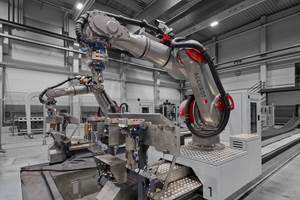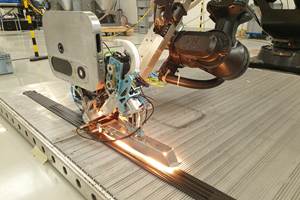NASA begins air taxi flight testing with Joby Aviation
The agency’s AAM National Campaign will apply what is learned about the composite eVTOL aircraft’s performance and acoustic date for future airspace concepts.

Joby’s eVTOL aircraft is pictured at the company's Electric Flight Base, located near Big Sur, Calif. Photo Credit: Joby Aviation
On Sept. 30 NASA (Washington, D.C., U.S.) began flight testing with Joby Aviation’s (Santa Cruz, Calif., U.S.) all-electric vertical takeoff and landing (eVTOL) aircraft (which recently hit range and noise targets) as part of the agency’s advanced air mobility (AAM) National Campaign. This testing runs through Sept. 10, at Joby’s Electric Flight Base located near Big Sur, Calif. This is the first time NASA will test an eVTOL aircraft as part of the campaign.
NASA’s goal is to collect vehicle performance and acoustic data for use in modeling and simulation of future airspace concepts. This test will reportedly help identify gaps in current Federal Aviation Administration (FAA) regulations and policies to help incorporate AAM aircraft into the National Airspace System. This multi-event campaign to advance airspace mobility in the U.S. will take place at multiple locations over several years.
“The National Campaign Developmental Testing is an important strategic step in NASA’s goals to accelerate the AAM industry timeline,” says Davis Hackenberg, NASA AAM mission integration manager. “These testing scenarios will help inform gaps in current standards to benefit the industry’s progress of integrating AAM vehicles into the airspace.”
During this round of testing, NASA will collect data from Joby’s eVTOL aircraft, which is intended to serve as a commercial passenger service in the future. Analyzing that data readies the AAM National Campaign to execute the first set of campaign tests, known as NC-1, slated for 2022, with more complex flight scenarios and other industry vehicles.
As the Joby aircraft flies planned test scenarios, the NASA team will collect information about how the vehicle moves, how the vehicle sounds and how the vehicle communicates with controllers. Future partners will fly similar scenarios to evaluate their vehicle readiness.
Moreover, the team will deploy the mobile acoustics facility and construct an array of more than 50 microphones to measure the acoustic profile of Joby’s aircraft in different phases of flight.
“NASA’s AAM National Campaign is critical to driving scientific understanding and public acceptance of eVTOL aircraft,” says JoeBen Bevirt, founder and CEO of Joby Aviation. “We’re incredibly proud to have worked closely with NASA on electric flight over the past 10 years and to be the first eVTOL company to fly as part of the campaign.”
Another element of the testing includes making sure external ranges participating in NC-1 meet the protocols for future testing by establishing a baseline to participate. The team will also test NASA’s flight safety and airworthiness processes to approve participants to fly in the campaign.
According to NASA, when fully integrated into the national airspace, AAM will provide an efficient and affordable system for passenger and cargo transportation, and other applications in the public interest. This system could include aircraft like package delivery drones, air taxis and medical transport vehicles.
The AAM National Campaign is managed by NASA’s AAM project, which plans to be a community catalyst for developing and validating system-level concepts and solutions for AAM. The AAM project is a part of the agency’s Aeronautics Research Mission Directorate.
Related Content
Automated robotic NDT enhances capabilities for composites
Kineco Kaman Composites India uses a bespoke Fill Accubot ultrasonic testing system to boost inspection efficiency and productivity.
Read MoreComposite sidewall cover expands options for fire-safe rail components
R&D project by CG Rail explores use of carbon fiber-reinforced thermoplastics and recycled manufacturing scrap to meet fire safety, weight and volume targets.
Read MoreThe basics of composite drawing interpretation
Knowing the fundamentals for reading drawings — including master ply tables, ply definition diagrams and more — lays a foundation for proper composite design evaluation.
Read MoreATLAM combines composite tape laying, large-scale thermoplastic 3D printing in one printhead
CEAD, GKN Aerospace Deutschland and TU Munich enable additive manufacturing of large composite tools and parts with low CTE and high mechanical properties.
Read MoreRead Next
Developing bonded composite repair for ships, offshore units
Bureau Veritas and industry partners issue guidelines and pave the way for certification via StrengthBond Offshore project.
Read More“Structured air” TPS safeguards composite structures
Powered by an 85% air/15% pure polyimide aerogel, Blueshift’s novel material system protects structures during transient thermal events from -200°C to beyond 2400°C for rockets, battery boxes and more.
Read MorePlant tour: Daher Shap’in TechCenter and composites production plant, Saint-Aignan-de-Grandlieu, France
Co-located R&D and production advance OOA thermosets, thermoplastics, welding, recycling and digital technologies for faster processing and certification of lighter, more sustainable composites.
Read More














.jpg;maxWidth=300;quality=90)








